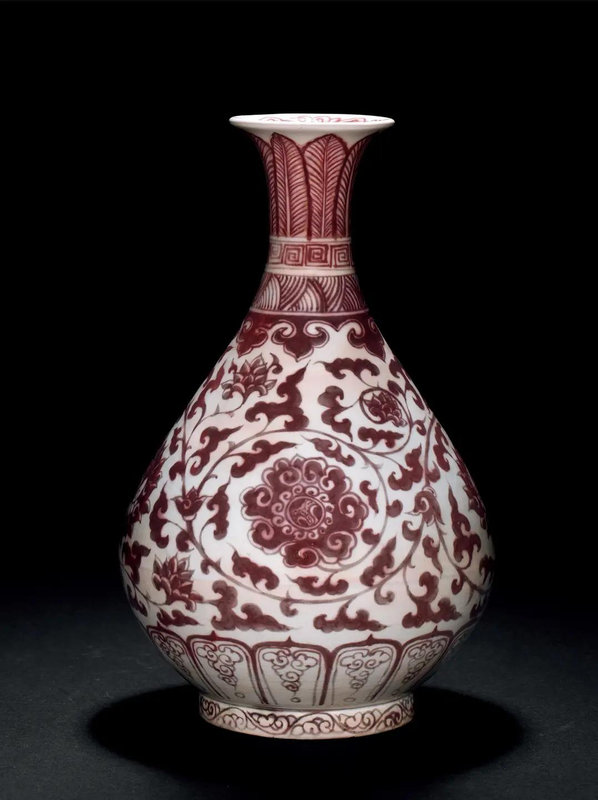An Underglaze-Red ‘Floral’ Pear-Shaped Vase, Yuhuchunping, Hongwu Period, 1368-1398
Lot 3577. An Underglaze-Red ‘Floral’ Pear-Shaped Vase, Yuhuchunping, Hongwu Period (1368-1398). H 33.5cm. Sold for HKD 4,200,000/USD 538,462 (Estimate HKD 2,500,000 - 4,500,000/USD 320,513 - 576,923). © Poly Auction Hong Kong Limited
This vessel is potted with the rounded sides supported on a flat base, rising to a straight rim incised with a single line border and set with an outward flaring spout above a fine coiled band of clay attached as a lug underneath. It is painted on the interior in vivid strokes of underglaze copper-red with a crane on an uneven ground under a tall leafy plant and in front of a single lotus leaf on a long stalk. All the patterns are enclosed within a red border incised with wavy lines reserved in white. The red color varies in shades from a vivid purplish tone to a dark reddish-grey. The glaze is tinged to pale blue while the unglazed rim and base are fired respectively to orange-red and cream-yellow.
Provenance: The Meiyintang Collection.
Literature: Regina Krahl, Chinese Ceramics from the Meiyintang Collection, vol. 2, London, 1994-2010, p.31, no.646.
Note: The name Yuhuchun was likely derived from a type of wine. Since the Tang dynasty, names of wine often include the character chun, meaning “spring”. The poet Zhou Quan accounts the Yuhuchun wine in his verses, stating that its fragrance is superior to wine made of grapes. Emperor Gaozong of Qing dynasty remarks in his poetry that the Yuhuchun vase is first used as a wine container. After its utilization for wine drinking, flowers are then cultivated in the container, turning it into a vase that was commonly known as the Yuhuchunping.
The vase is potted in an elegant classic pear shape supported on a short foot rising to a generous rounded body surmounted by a waisted neck flaring at the mouth. The exterior is painted in copper-red with a broad band of undulating stems of lotus bearing large blooms alternatively depicted in different styles. Each arched stem ends in a small subsidiary blossom, all between upright lappets at the base and a collar of trefoil pendants dangling from overlapping waves, a keyfret border and upright plantain leaves at the neck. The inner mouthrim and the foot are painted with classic scroll.
Copper as a colouring agent is particularly unstable in the firing process, thus it carries a high possibility of becoming runny and leaving indistinct outlines or resulting to weak shades of red and pale grey tones. The strong copper tones and clearly-penciled designs of this vase sets it apart as a highly successful and skillfully manufactured piece.
A closely related example from the Qing Court Collection in the Palace Museum, Beijing, is published in The Complete Collection of Treasures of the Palace Museum. Blue and White Porcelain with Underglaze Red, vol. 1, Shanghai, 2000, pl. 197; and another in the Tokyo National Museum is illustrated in Oriental Ceramics. The World’s Great Collections, vol. 1, Tokyo, 1982, pl. 112. Compare also vases decorated with various bands of decoration on the neck, such as one in the Palace Museum, Beijing, illustrated op. cit., pl. 196.
Poly Auction. A Romance Among Blooming Roses: The Meiyintang Collection of Three Dynasties Imperial Ceramics, Hong Kong, 2 December 2021

/https%3A%2F%2Fprofilepics.canalblog.com%2Fprofilepics%2F1%2F0%2F100183.jpg)
/https%3A%2F%2Fstorage.canalblog.com%2F03%2F02%2F119589%2F96711876_o.jpg)
/https%3A%2F%2Fstorage.canalblog.com%2F11%2F31%2F119589%2F94773502_o.jpg)
/https%3A%2F%2Fstorage.canalblog.com%2F20%2F83%2F119589%2F94772815_o.jpg)
/https%3A%2F%2Fstorage.canalblog.com%2F26%2F72%2F119589%2F75604929_o.jpg)
/https%3A%2F%2Fstorage.canalblog.com%2F59%2F60%2F119589%2F26458628_o.jpg)



/image%2F1371349%2F20240416%2Fob_65a1d8_telechargement-31.jpg)
/image%2F1371349%2F20240410%2Fob_645a50_2024-nyr-22642-0910-000-a-russet-paint.jpg)
/http%3A%2F%2Fstorage.canalblog.com%2F85%2F43%2F119589%2F129542325_o.jpg)
/http%3A%2F%2Fstorage.canalblog.com%2F48%2F20%2F119589%2F129532416_o.jpg)